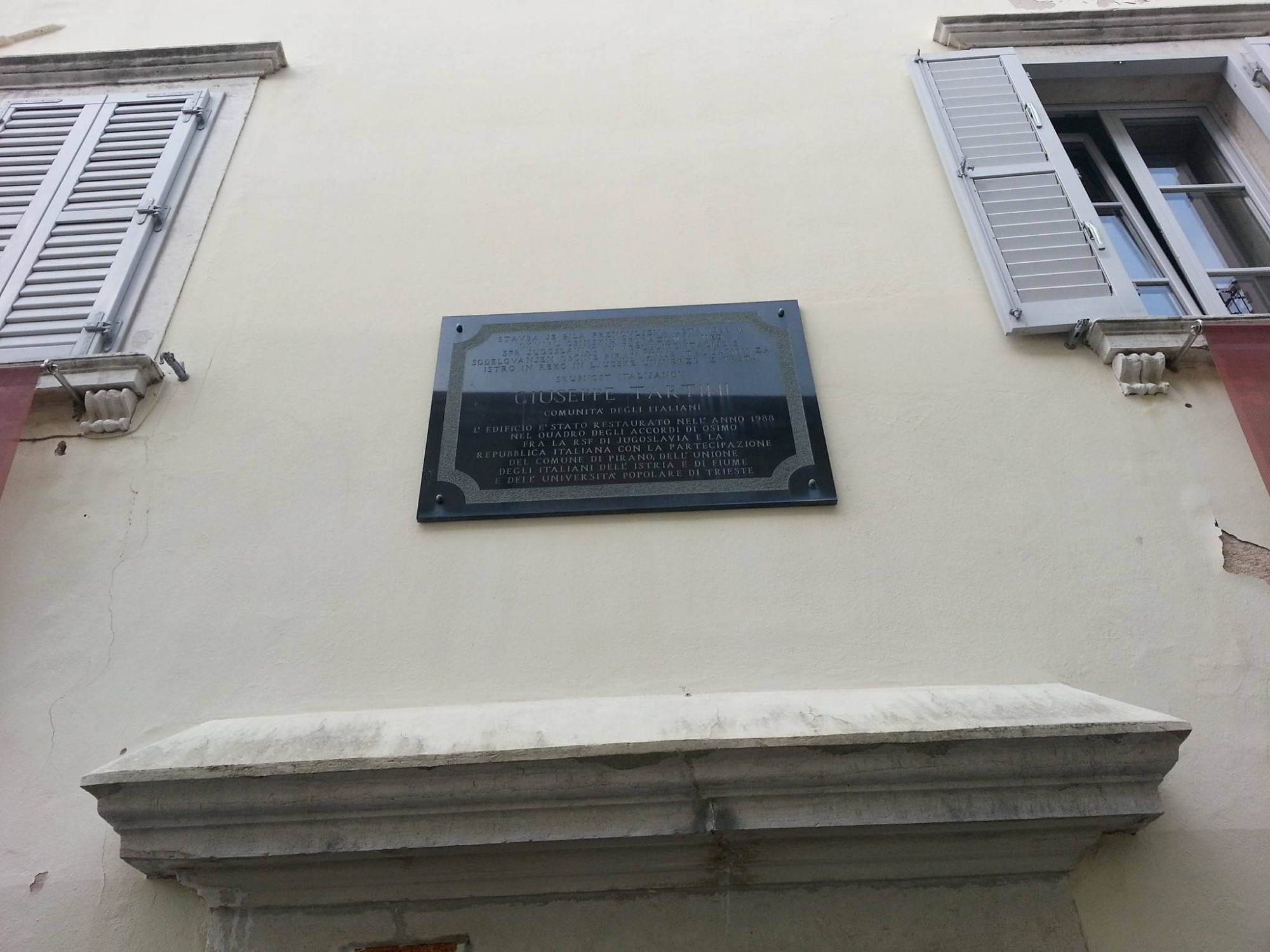Commissioned by the brothers Pietro and Domenico Vatta in 1846, the plaque is the oldest memorial dedicated to the great violin virtuoso and composer in his native town.
A GIUSEPPE TARTINI
NATO IN QUESTA CASA IL XII APRILE MDCXCII
DONDE MOSSE A BEAR EVROPA
CON MELODIA DI VIOLINO MARAVIGLIOSA
E CON OPERE DI SCIENZA MUSICALE
PERCHE LA VIRTU DI TANTO UOMO
NELLE PATRIE ARMONIE SI DIFFONDA
I FRATELLI VATTA
INNALZANO MEMORIA DI ONORE
MDCCCXLVI
Giuseppe Tartini
Piran-born violin virtuoso and music theorist Giuseppe Tartini (1692–1770) was a composer of late baroque and early classicism. Working most of his life in the Republic of Venice, mainly in Padua, his legacy – particularly the family documents and theoretical writings kept in his birthplace – bears testimony to the composer’s early period in his native town.
Tartini’s father, Giovanni Antonio, was the director of the Piran saltpans and intended his son to become a friar. To this end, Tartini received a musical training in Piran and was later enrolled in the Collegio dei padri delle scuole Pie in Koper/Capodistria, where he also took instruction in humanities and rhetoric. He left his native town in 1708 never to return, although the land and the specific features of its music folklore purportedly – according to references found in some of his writings – made a lasting impression on him. Tartini studied law at Padua, and at the same time established a reputation as a fencer.
After his father’s death in 1710, he married Elisabetta Premazore, a woman who would have incurred his father’s disapproval, because of her lower social class and age difference. In marrying Elisabetta, Tartini offended the sentiments of the powerful Cardinal Giorgio Cornaro, and consequently took refuge at Assisi. In the St Francis Monastery, Tartini enjoyed the protection of Father Torre, a kinsman from Piran, and after his death, supported himself as a musician. We learn from his Trattato di musica (Treatise on Music) that he was in the orchestra of the Ancona Opera in 1714. He claimed that it had been then that he discovered the acoustic phenomenon of terzo suono, or the combination tone. The discovery was to play an essential role in his theories and influenced his composing and violin technique. While Tartini’s relatively idiosyncratic mathematical ideas made only a marginal impact at the time, his findings in physics later laid a foundation for contemporary acoustics.
Tartini held concerts at Parma (1728), Bologna (1730), Camerino (1735), Ferrara (1739) and, particularly, Venice. He established a violin school in Padua, which attracted students from all over Europe, and Tartini was dubbed ‘a maestro (teacher) of nations’. His school focused intensively on establishing a modern style of violin bowing, introducing techniques that enabled the performance of Tartini’s innovative music style. Besides violin playing, Tartini taught composition.
The first notable owner of a Stradivarius violin, Tartini later presented it to one of his talented students, Mazzurani, who gave it to a Polish composer and violinist, Karol Lipiński (the instrument is today known as the Lipinski Stradivarius).
Tartini’s extensive music creativity is marked by two instrumental genres, solo works for violin (concerti) and violin sonatas. His instrumental output, amounting to approximately 130 concerti and over 180 chamber works, is complemented by an oeuvre of around 20 religious vocal pieces. Tartini’s style reflects the marked influence of Arcangelo Corelli.
The genesis of Tartini’s foremost violin sonata in G minor, Trillo del Diavolo (Devil’s Trill), is surrounded by an aura of mysticism. Tartini wrote the piece after waking from a particularly vivid dream of the Devil – with whom he had made a pact for his soul – playing a violin with breath-taking virtuosity.
Maia Juvanc

